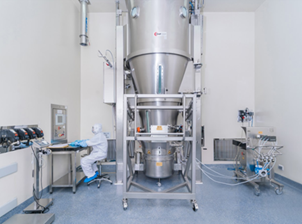Technology transfer aims to commercialize products successfully at your contract manufacturing organization (CMO) partner site. This means the manufacturing, analytics, packaging, relevant documentation, and professional expertise should be involved in the process. It is inevitable that problems and challenges can be encountered during the technology transfer of any pharmaceutical product. However, by working closely together with your CMO partner, these problems and challenges can be successfully overcome. This article aims to provide tips and instructions to make sure a technology transfer is smoothly and successfully executed with your CMO partner to ensure minimal lot-to-lot variability during routine manufacturing and packaging operations.
Development and Review of Process Design
 Pharmaceutical product technology transfers are often implemented at different production scales or equipment compared to the original process. The challenge is how to establish process parameters with the new equipment/batch size from the transferring manufacturing site to another site, usually to the CMO chosen by the product owner, while maintaining the quality requirements of the pharmaceutical product.
Pharmaceutical product technology transfers are often implemented at different production scales or equipment compared to the original process. The challenge is how to establish process parameters with the new equipment/batch size from the transferring manufacturing site to another site, usually to the CMO chosen by the product owner, while maintaining the quality requirements of the pharmaceutical product.
The technology transfer process design should take into account the aforementioned differences. The only strategy in overcoming these challenges is that the product owner (client) and CMO teams work closely together to develop practical solutions. As much information provided as possible by the client can further minimize any misunderstandings or knowledge gaps during technology transfer.
First Step is Information Transfer
The technology transfer package is the collection of all knowledge and documentation required to run the process and analyze the product. In many instances, this first step is crucial to a successful completion of a product technology transfer. Depending on the stage of the product life cycle, this “hand-off” may include:
- Product Development Report
- Process and Packaging Validation Studies
- Additional supporting document, including Bulk Holding Study, Shipping study, or Elemental Impurity Assessment report
- Historical results and annual product review reports
- In-process control and finished product specification
- Instruments, equipment, facilities, raw materials and suppliers.
- Product Quality Attributes (e.g., Critical Quality Attributes (CQA’s) and material attributes)
- Overview of processes, including unit operations (e.g., Critical Process Parameters (CPP’s) and material attributes)
- Control strategy
- Manufacturing process parameters
- Continuous improvement ideas and plans
- Historical Deviation lists
- Equipment list
- Product Cleaning procedures
- Packaging components and suppliers
- Analytical Testing package, including analytical methods, specifications for materials and products.
- Health, safety, and environmental (EHS) requirement
At the outset of a technology transfer, the CMO or receiving site should perform a risk assessment according to the information provided by the client or product owner. The risk assessment should cover all activities that should be included in technology transfer. Both parties should review and approve the assessment to make sure all information is aligned and risk is mitigated.
Expect comprehensive information transfer, there are also some recommendations to avoid any potential problems.
Plan Well and Set Common Goals
Any technology transfer begins with a thorough feasibility evaluation, where all the different aspects of the project should be considered and evaluated. Rushing the initial planning phase is not a good idea. Thorough consideration at the feasibility phase can prevent problems later on during a technology transfer that can lead to additional work scope and delays in commercializing the product and in the hands of patients.
Communicate Transparently and Frequently
The right communication strategies are crucial for successful technology transfers. It’s wise to set up common meeting practices and establish transparent, frequent communications between the client and their CMO partner. A joint team from both partners would guarantee agile communication and responsiveness to ensure a smooth transfer. The most important requirement is a partnership between the client and the CMO that is built on mutual trust and respect.
Engineering Runs Are a Critical Step in the Technology Transfer Process
Engineering runs are performed to identify and resolve process and equipment issues that may arise. It has become a standard practice to include engineering runs as part of technology transfer projects regardless of dosage form, in spite of the resources and time they are perceived to consume. Over time, it has become clear to anyone involved in technology transfers that a successful engineering run guarantees quality for the subsequent cGMP manufacturing and packaging runs. Adequate time should be allowed between the Engineering runs and cGMP Production runs to assess the results of the Engineering runs to confirm and set the parameters. Troubleshooting of process parameters should be completed during engineering runs, and a minimum of one successful engineering run should be completed before initiating the production of Registration batches for submission to the Regulatory Authorities, such as USFDA, for the approval of site transfer.
Example of Qualifying In-Process Capsule Filling Weight Controls
 Few years ago, we worked with a client’s R&D team to launch a brand product at our site. It was a capsule product with several different components. In the beginning, we utilized MG2 for the encapsulation process. However, it was challenged by USFDA since the capsule filler could not measure the individual component weights during the encapsulation process. In order to solve the issue, we worked with the client to change to an IMA capsule filler which could test the individual component weights during in-process control. Finally, USFDA agreed to the approach we adopted. The brand product was successfully commercialized and boosted revenue for our client. With the technology transfer successfully completed, consistent, predictable product supply was achieved that has allowed the client to realize their market share and revenue goals.
Few years ago, we worked with a client’s R&D team to launch a brand product at our site. It was a capsule product with several different components. In the beginning, we utilized MG2 for the encapsulation process. However, it was challenged by USFDA since the capsule filler could not measure the individual component weights during the encapsulation process. In order to solve the issue, we worked with the client to change to an IMA capsule filler which could test the individual component weights during in-process control. Finally, USFDA agreed to the approach we adopted. The brand product was successfully commercialized and boosted revenue for our client. With the technology transfer successfully completed, consistent, predictable product supply was achieved that has allowed the client to realize their market share and revenue goals.
Lessons Learned
To avoid similar events for future technology transfers, our team works with clients closely. Not only by following the original equipment trains from clients, but also by providing our expertise during technology transfers to make sure the transferred product can be commercialized in a timely and efficient manner. By following this approach, issues and challenges are significantly reduced and client satisfaction with overall product quality and performance.



